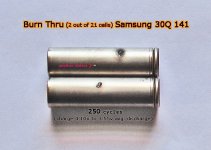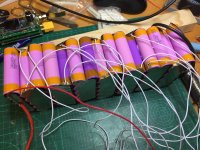eMark
100 kW
From 1/2/21 thru 2/14/21 (44 days) 20 out of the 30 “141” cells had self-discharge no greater than 0.005V. Then reassembled again in the 30Q 10S3P experimental Vruzend pack--now being tested for p-group self-discharge ...
141--141--141--141--141.......141--141--141--141--141
.K.....K.....K.....K....141.........K.....K.....K.....K.....K
141--141--141--141--141.......141--141--141--141--141
From 7/22/21 thru 7/28/21 only three of the ten p-groups had self-discharge less than 0.005V after 7 days; while four p-groups had self-discharge no greater than 0.01V after 7 days. The other three p-groups (blue type) had self-discharge that ranged from 0.04V to 0.11V after just 7 days ...
4.03--4.03--4.03--4.03--4.03……...4.03--4.03--4.03--4.03--4.03
variance among 10 p-group voltages after seven days from 7/22 thru 7/28
4.03..4.02..4.02..3.99..4.03……...4.02--4.00--3.92--4.02--4.03
The “141” cell in the middle "K" row diagram had the least amount of self-discharge (Sub Pack 1 2S-2P 0.02V) of the ten cells with self-discharge from 1/2/21 to 1/15/21 (see ten high-lighted cells in the previous post at bottom of page 3). This "141" cell was used to replace the new/unused defective “KH1T” cell suffering from significant self-discharge possibly due to the can wall puncture as received and visible only after wrap removed to check can codes ...
141--141--141--141--141.......141--141--141--141--141
.K.....K.....K.....K....141.........K.....K.....K.....K.....K
141--141--141--141--141.......141--141--141--141--141
From 7/22/21 thru 7/28/21 only three of the ten p-groups had self-discharge less than 0.005V after 7 days; while four p-groups had self-discharge no greater than 0.01V after 7 days. The other three p-groups (blue type) had self-discharge that ranged from 0.04V to 0.11V after just 7 days ...
4.03--4.03--4.03--4.03--4.03……...4.03--4.03--4.03--4.03--4.03
variance among 10 p-group voltages after seven days from 7/22 thru 7/28
4.03..4.02..4.02..3.99..4.03……...4.02--4.00--3.92--4.02--4.03
The “141” cell in the middle "K" row diagram had the least amount of self-discharge (Sub Pack 1 2S-2P 0.02V) of the ten cells with self-discharge from 1/2/21 to 1/15/21 (see ten high-lighted cells in the previous post at bottom of page 3). This "141" cell was used to replace the new/unused defective “KH1T” cell suffering from significant self-discharge possibly due to the can wall puncture as received and visible only after wrap removed to check can codes ...





